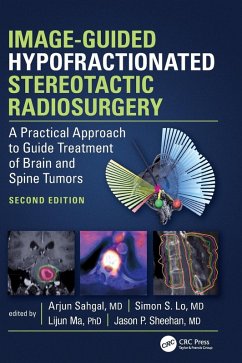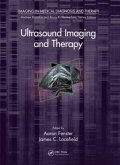Image-Guided Hypofractionated Stereotactic Radiosurgery
A Practical Approach to Guide Treatment of Brain and Spine Tumors
Herausgeber: Sahgal, Arjun
Image-Guided Hypofractionated Stereotactic Radiosurgery
A Practical Approach to Guide Treatment of Brain and Spine Tumors
Herausgeber: Sahgal, Arjun
- Gebundenes Buch
- Merkliste
- Auf die Merkliste
- Bewerten Bewerten
- Teilen
- Produkt teilen
- Produkterinnerung
- Produkterinnerung
Following recent developments in hypofractionated stereotactic radiation therapy for brain and spine tumours, this new edition offers a fully updated and comprehensive, how-to guidance on hypofractionated SRT for brain and spine metastases, glioma, benign tumors, and other tumor types.
Andere Kunden interessierten sich auch für
![Medical Image Synthesis Medical Image Synthesis]() Medical Image Synthesis264,99 €
Medical Image Synthesis264,99 €![Image-Guided Stereotactic Radiosurgery Image-Guided Stereotactic Radiosurgery]() Harun BadakhshiImage-Guided Stereotactic Radiosurgery81,99 €
Harun BadakhshiImage-Guided Stereotactic Radiosurgery81,99 €![Ultrasound Imaging and Therapy Ultrasound Imaging and Therapy]() Ultrasound Imaging and Therapy276,99 €
Ultrasound Imaging and Therapy276,99 €![Adaptive Radiation Therapy Adaptive Radiation Therapy]() Adaptive Radiation Therapy252,99 €
Adaptive Radiation Therapy252,99 €![Practical Medical Physics Practical Medical Physics]() Practical Medical Physics190,99 €
Practical Medical Physics190,99 €![The Practice of Internal Dosimetry in Nuclear Medicine The Practice of Internal Dosimetry in Nuclear Medicine]() Michael G StabinThe Practice of Internal Dosimetry in Nuclear Medicine127,99 €
Michael G StabinThe Practice of Internal Dosimetry in Nuclear Medicine127,99 €![Radiochromic Film Radiochromic Film]() Radiochromic Film252,99 €
Radiochromic Film252,99 €-
-
-
Following recent developments in hypofractionated stereotactic radiation therapy for brain and spine tumours, this new edition offers a fully updated and comprehensive, how-to guidance on hypofractionated SRT for brain and spine metastases, glioma, benign tumors, and other tumor types.
Produktdetails
- Produktdetails
- Verlag: CRC Press
- 2nd edition
- Seitenzahl: 616
- Erscheinungstermin: 22. Juli 2021
- Englisch
- Abmessung: 254mm x 178mm x 33mm
- Gewicht: 1279g
- ISBN-13: 9780367462789
- ISBN-10: 0367462788
- Artikelnr.: 62480370
- Verlag: CRC Press
- 2nd edition
- Seitenzahl: 616
- Erscheinungstermin: 22. Juli 2021
- Englisch
- Abmessung: 254mm x 178mm x 33mm
- Gewicht: 1279g
- ISBN-13: 9780367462789
- ISBN-10: 0367462788
- Artikelnr.: 62480370
Arjun Sahgal, MD (chief editor), is a leader in the field of high-precision stereotactic radiation to the brain and spine. After training at the University of Toronto, Ontario, Canada, in radiation oncology, he completed a fellowship at the University of California, San Francisco, in brain and spine radiosurgery with Dr. David Larson. Since then he has been recognized as a national and international clinical expert and research leader in radiosurgery. His main focus is on developing spine stereotactic body radiotherapy as an effective therapy for patients with spinal tumors. He has published numerous book chapters on the subject and more than 200 peer-reviewed papers in high-impact journals, including Journal of Clinical Oncology and The Lancet Oncology. He has edited or written several books specific to research on brain and bone metastases and is an editorial board member for several journals. He was chairman of the International Stereotactic Radiosurgery Society meeting (June 2013) and was a board member for the Brain Tumour Foundation of Canada and the International Stereotactic Radiosurgery Society. He has been invited to speak at several international meetings, has been a visiting professor at various universities, and leads several research groups. His further research activities involve integrating MRI into radiotherapy delivery, combining novel pharmacologic therapies with radiosurgery, and MRI-guided focused ultrasound.
1. Tumor Vascular Modulation: Role of Endothelial cells, Ceramide and
Vascular Targeted Therapies 2. Gamma Knife: From single fraction SRS to
IG-HSRT 3. CyberKnife image-guided hypofractionated stereotactic
radiotherapy 4. Li5. nac-based IG-HSRT technology 5. Advanced MRI for brain
metastases 6. From frame to frameless: Brain radiosurgery 7. Principles of
image-guided hypofractionated stereotactic radiosurgery for brain tumors 8.
Principles of image-guided hypofractionated radiotherapy of spine
metastases 9. Spine stereotactic body radiotherapy for the treatment of de
novo spine metastasis 10. Image-guided hypofractionated stereotactic
radiotherapy for reirradiation of spinal metastases I1. G-HSRT for benign
tumors of the spine 12. Postoperative spine IG-HSRT outcomes 13.
Postoperative cavity image-guided stereotactic radiotherapy outcomes 14.
Brain metastases image-guided hypofractionated radiation therapy:
Rationale, approach, outcomes 15. Image-guided hypofractionated
stereotactic whole-brain radiotherapy and simultaneous integrated boost for
brain metastases 16. Image-guided hypofractionated radiation therapy for
high-grade glioma 17. Hypo-fractionated stereotactic radiotherapy for
meningiomas, vestibular schwannomas and pituitary adenomas 18. Radiation
Necrosis 19. Vertebral compression fracture post-spine SBRT 20. Spinal cord
dose limits for stereotactic body radiotherapy 21. Summary of image-guided
hypofractionated stereotactic radiotherapy (IG-HSRT): Serious Late
Toxicities and Strategies to Mitigate Risk 22. MR-guided focused ultrasound
for brain tumors 23. Laser Thermal Therapy for Brain Tumors 24. Updates on
laser interstital therapy for metastatic tumors of the spine 25.
Stereotactic Radiotherapy & Intracranial Leptomeningeal Disease 26.
Minimally invasive percutaneous treatment in the palliation of painful bone
metastases 27. Proton stereotactic radiosurgery for brain metastases 28.
The Zap-X: A Novel 3 Megavolt Linear Accelerator for Dedicated Intracranial
Stereotactic Radiosurgery 29. Immunotherapy and Radiosurgery for Brain and
Spine Metastases 30. 24 Gy in 2 Daily Spine SBRT Fractions as Developed by
the Sunnybrook Health Sciences Centre 31. MRI for spinal metastases and
response determination 32. Stereotactic Body Radiotherapy (SBRT) for
Metastatic Disease to the Sacrum 33. Radiomics and its Role in Predicting
Radiotherapy Response and Outcome in Brain Metastasis
Vascular Targeted Therapies 2. Gamma Knife: From single fraction SRS to
IG-HSRT 3. CyberKnife image-guided hypofractionated stereotactic
radiotherapy 4. Li5. nac-based IG-HSRT technology 5. Advanced MRI for brain
metastases 6. From frame to frameless: Brain radiosurgery 7. Principles of
image-guided hypofractionated stereotactic radiosurgery for brain tumors 8.
Principles of image-guided hypofractionated radiotherapy of spine
metastases 9. Spine stereotactic body radiotherapy for the treatment of de
novo spine metastasis 10. Image-guided hypofractionated stereotactic
radiotherapy for reirradiation of spinal metastases I1. G-HSRT for benign
tumors of the spine 12. Postoperative spine IG-HSRT outcomes 13.
Postoperative cavity image-guided stereotactic radiotherapy outcomes 14.
Brain metastases image-guided hypofractionated radiation therapy:
Rationale, approach, outcomes 15. Image-guided hypofractionated
stereotactic whole-brain radiotherapy and simultaneous integrated boost for
brain metastases 16. Image-guided hypofractionated radiation therapy for
high-grade glioma 17. Hypo-fractionated stereotactic radiotherapy for
meningiomas, vestibular schwannomas and pituitary adenomas 18. Radiation
Necrosis 19. Vertebral compression fracture post-spine SBRT 20. Spinal cord
dose limits for stereotactic body radiotherapy 21. Summary of image-guided
hypofractionated stereotactic radiotherapy (IG-HSRT): Serious Late
Toxicities and Strategies to Mitigate Risk 22. MR-guided focused ultrasound
for brain tumors 23. Laser Thermal Therapy for Brain Tumors 24. Updates on
laser interstital therapy for metastatic tumors of the spine 25.
Stereotactic Radiotherapy & Intracranial Leptomeningeal Disease 26.
Minimally invasive percutaneous treatment in the palliation of painful bone
metastases 27. Proton stereotactic radiosurgery for brain metastases 28.
The Zap-X: A Novel 3 Megavolt Linear Accelerator for Dedicated Intracranial
Stereotactic Radiosurgery 29. Immunotherapy and Radiosurgery for Brain and
Spine Metastases 30. 24 Gy in 2 Daily Spine SBRT Fractions as Developed by
the Sunnybrook Health Sciences Centre 31. MRI for spinal metastases and
response determination 32. Stereotactic Body Radiotherapy (SBRT) for
Metastatic Disease to the Sacrum 33. Radiomics and its Role in Predicting
Radiotherapy Response and Outcome in Brain Metastasis
1. Tumor Vascular Modulation: Role of Endothelial cells, Ceramide and
Vascular Targeted Therapies 2. Gamma Knife: From single fraction SRS to
IG-HSRT 3. CyberKnife image-guided hypofractionated stereotactic
radiotherapy 4. Li5. nac-based IG-HSRT technology 5. Advanced MRI for brain
metastases 6. From frame to frameless: Brain radiosurgery 7. Principles of
image-guided hypofractionated stereotactic radiosurgery for brain tumors 8.
Principles of image-guided hypofractionated radiotherapy of spine
metastases 9. Spine stereotactic body radiotherapy for the treatment of de
novo spine metastasis 10. Image-guided hypofractionated stereotactic
radiotherapy for reirradiation of spinal metastases I1. G-HSRT for benign
tumors of the spine 12. Postoperative spine IG-HSRT outcomes 13.
Postoperative cavity image-guided stereotactic radiotherapy outcomes 14.
Brain metastases image-guided hypofractionated radiation therapy:
Rationale, approach, outcomes 15. Image-guided hypofractionated
stereotactic whole-brain radiotherapy and simultaneous integrated boost for
brain metastases 16. Image-guided hypofractionated radiation therapy for
high-grade glioma 17. Hypo-fractionated stereotactic radiotherapy for
meningiomas, vestibular schwannomas and pituitary adenomas 18. Radiation
Necrosis 19. Vertebral compression fracture post-spine SBRT 20. Spinal cord
dose limits for stereotactic body radiotherapy 21. Summary of image-guided
hypofractionated stereotactic radiotherapy (IG-HSRT): Serious Late
Toxicities and Strategies to Mitigate Risk 22. MR-guided focused ultrasound
for brain tumors 23. Laser Thermal Therapy for Brain Tumors 24. Updates on
laser interstital therapy for metastatic tumors of the spine 25.
Stereotactic Radiotherapy & Intracranial Leptomeningeal Disease 26.
Minimally invasive percutaneous treatment in the palliation of painful bone
metastases 27. Proton stereotactic radiosurgery for brain metastases 28.
The Zap-X: A Novel 3 Megavolt Linear Accelerator for Dedicated Intracranial
Stereotactic Radiosurgery 29. Immunotherapy and Radiosurgery for Brain and
Spine Metastases 30. 24 Gy in 2 Daily Spine SBRT Fractions as Developed by
the Sunnybrook Health Sciences Centre 31. MRI for spinal metastases and
response determination 32. Stereotactic Body Radiotherapy (SBRT) for
Metastatic Disease to the Sacrum 33. Radiomics and its Role in Predicting
Radiotherapy Response and Outcome in Brain Metastasis
Vascular Targeted Therapies 2. Gamma Knife: From single fraction SRS to
IG-HSRT 3. CyberKnife image-guided hypofractionated stereotactic
radiotherapy 4. Li5. nac-based IG-HSRT technology 5. Advanced MRI for brain
metastases 6. From frame to frameless: Brain radiosurgery 7. Principles of
image-guided hypofractionated stereotactic radiosurgery for brain tumors 8.
Principles of image-guided hypofractionated radiotherapy of spine
metastases 9. Spine stereotactic body radiotherapy for the treatment of de
novo spine metastasis 10. Image-guided hypofractionated stereotactic
radiotherapy for reirradiation of spinal metastases I1. G-HSRT for benign
tumors of the spine 12. Postoperative spine IG-HSRT outcomes 13.
Postoperative cavity image-guided stereotactic radiotherapy outcomes 14.
Brain metastases image-guided hypofractionated radiation therapy:
Rationale, approach, outcomes 15. Image-guided hypofractionated
stereotactic whole-brain radiotherapy and simultaneous integrated boost for
brain metastases 16. Image-guided hypofractionated radiation therapy for
high-grade glioma 17. Hypo-fractionated stereotactic radiotherapy for
meningiomas, vestibular schwannomas and pituitary adenomas 18. Radiation
Necrosis 19. Vertebral compression fracture post-spine SBRT 20. Spinal cord
dose limits for stereotactic body radiotherapy 21. Summary of image-guided
hypofractionated stereotactic radiotherapy (IG-HSRT): Serious Late
Toxicities and Strategies to Mitigate Risk 22. MR-guided focused ultrasound
for brain tumors 23. Laser Thermal Therapy for Brain Tumors 24. Updates on
laser interstital therapy for metastatic tumors of the spine 25.
Stereotactic Radiotherapy & Intracranial Leptomeningeal Disease 26.
Minimally invasive percutaneous treatment in the palliation of painful bone
metastases 27. Proton stereotactic radiosurgery for brain metastases 28.
The Zap-X: A Novel 3 Megavolt Linear Accelerator for Dedicated Intracranial
Stereotactic Radiosurgery 29. Immunotherapy and Radiosurgery for Brain and
Spine Metastases 30. 24 Gy in 2 Daily Spine SBRT Fractions as Developed by
the Sunnybrook Health Sciences Centre 31. MRI for spinal metastases and
response determination 32. Stereotactic Body Radiotherapy (SBRT) for
Metastatic Disease to the Sacrum 33. Radiomics and its Role in Predicting
Radiotherapy Response and Outcome in Brain Metastasis








